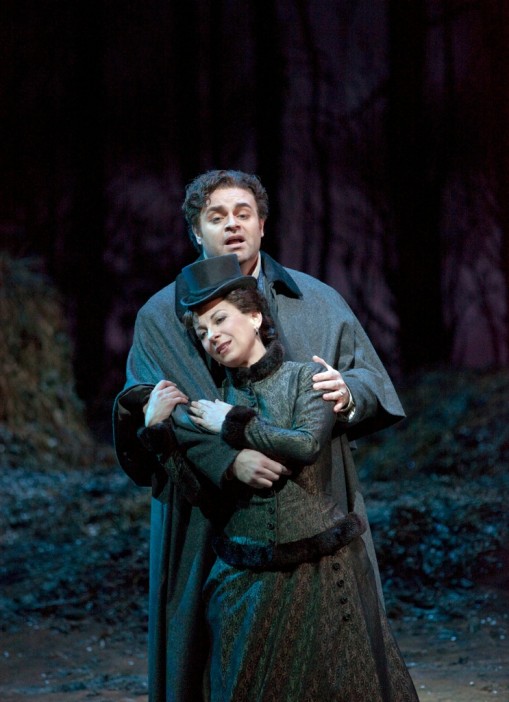Worthy singing undone by Zimmerman’s conceits, endless intervals in Met’s “Lucia”

Natalie Dessay and Joseph Calleja in the Metropolitan Opera production of "Lucia di Lammermoor." Photo: Ken Howard.
If one were asked to name the most irritating aspect of Mary Zimmerman’s production of Lucia di Lammermoor at the Metropolitan Opera the female ghost who turns up during Lucia’s Act 1 aria and again for Edgardo’s suicide scene would be a strong contender. In a program essay relating the real-life background of the Lucia story, Zimmerman writes that ghosts inhabit the opera’s source novel by Sir Walter Scott. Yet the ghost here looks silly at her first appearance and later, as she assists Edgardo in planting the fatal dagger in his gut, proves to be a major distraction in a scene that is potentially the most moving of the opera.
Nevertheless, at the season premiere of the Donizetti opera last night, a shortcoming of a more mundane nature also brought frustrations—the length of the intermissions. The program now contains a note advising that the second intermission will last 40 minutes, apparently because of difficulty in getting a large staircase and a pedestrian bridge in place for the Mad Scene. (Don’t ask why this very set glides with such apparent ease into the wings at the scene’s conclusion.) In fact, the break lasted slightly longer, but the really perplexing thing was that the first intermission was almost as long. Let’s hope that by now the Met has adopted a motto of “less is more” or whatever it takes to ban overly elaborate scenery that necessitates so colossal a waste of the audience’s time.
On the plus side, the evening offered an appreciable amount of good singing. Natalie Dessay was the production’s first Lucia when the production was new in 2007 and, after ceding the role in intervening years to such sopranos as Diana Damrau and Anna Netrebko, returns to reclaim it. The voice is smaller than Met audiences are accustomed to for Lucia, and, if memory serves, perhaps even in comparison with her own prior performances. Act 1 especially needed more of an assertive, take-charge manner. Yet the voice retains its iridescent beauty, and once Dessay began charting Lucia’s mental demise, her performance came into its own, with singing of delicate details and vocal colors.
Lucia’s unraveling begins with the duet for her and her brother Enrico in Act 2, which Dessay initiated with great assurance but changed gears tellingly when Lucia’s confidence is shattered after she reads forged letters purporting to show Edgardo’s faithlessness. Brother Enrico is the first of the men in Lucia’s life who successively side against her. The second is her trusted but weak tutor Raimondo, who urges her to accede in the marriage arranged by Enrico. And finally there is Edgardo himself, by rights her champion. But, feeling betrayed himself, he turns out to be the most verbally abusive of the three.
Dessay projects a vulnerability that conveys the full cumulative impact of these confrontations. She makes the Mad Scene seem like the only logical outcome and sang it touchingly, even if she sometimes strayed from pitch. She is to be commended for dispensing with the bogus traditional cadenza with flute, though what she sang included much of the same music, just without the solo wind obbligato.
The performance also included the first Met Edgardo of tenor Joseph Calleja, who won a warm reception from the audience. Tall, and ardent in voice and manner, he brought an emotional charge to Edgardo music, especially his curse of Lucia. Still, the quality of the voice will not please everyone. Though vibrant and plenty strong, it lacks ring and resonance, and sometimes its fast vibrato can intrude. But debate over these issues goes back at least as far as the days of Fernando de Lucia and will be ultimately resolved by listeners in their own way. In any case, Calleja’s Edgardo has much to recommend it.
Enrico comes off as especially villainous in this production, and Ludovic Tézier’s handsome, robust baritone filled the bill in hearty fashion. He sang only one verse of the cabaletta in the first scene but seemed to try to make up for it by holding a loud, interpolated high note at the end as long as possible. The excellent bass Kwangchul Youn brought gravity and sensitivity to Raimondo’s pronouncements. As Arturo, tenor Matthew Plenk not only sang beautifully in the celebrated episode within the opening chorus of Act 2, scene 2, but went on to show concern for Lucia’s well being.
Despite the ghost and the long scene change, Zimmerman’s production, which updates the action to sometime around 1900, has some worthy things going for it. Even the photographer, who arranges the characters during the fraught sextet, while much criticized when the production was new, reminds us that decorum often masks underlying tensions in a wedding.
Patrick Summers leads a competently paced performance. He observed a cut in the exciting music that closes the finale of Act 2, which was performed complete when the production was new. And in another regression, flute replaced the eerie sound of the glass harmonica in the Mad Scene. But this is hardly the first revival to supplant correct musical choices by sliding back to the bad old way of doing things.
Lucia di Lammermoor runs through March 19. metopera.org